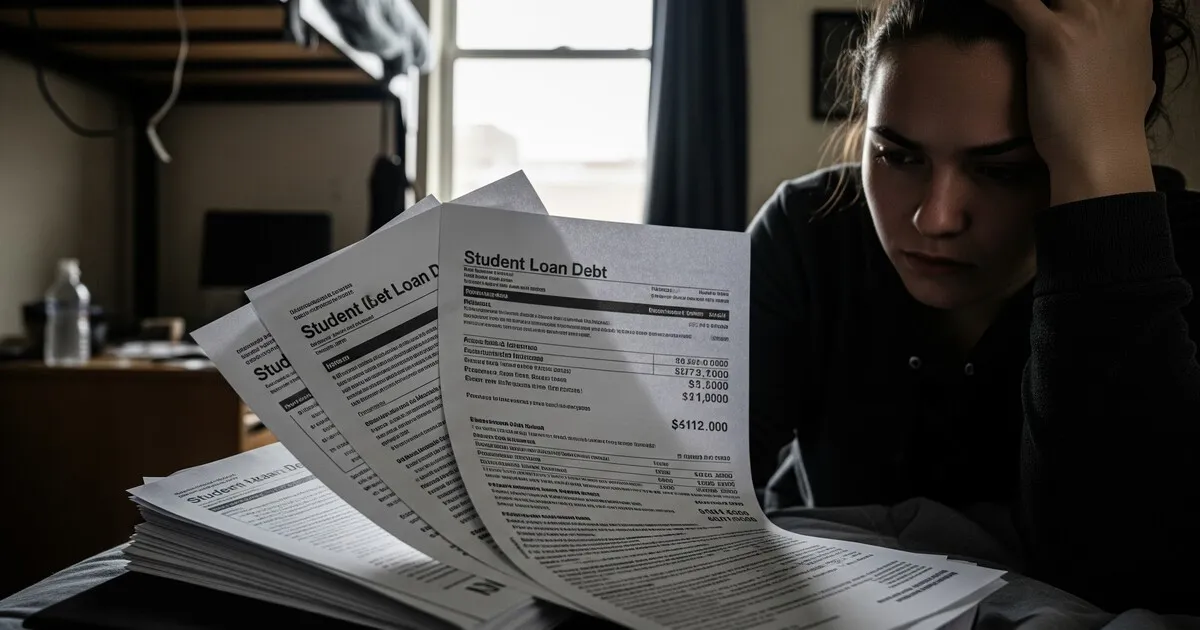Bitcoin: How To Solve the Student Loan Crisis
Bitcoin Magazine Bitcoin: How To Solve the Student Loan Crisis Students are already taking out mortgage-sized loans for college. The financial jiu-jitsu of pairing bitcoin with student loans can fix the student debt crisis. This post Bitcoin: How To Solve the Student Loan Crisis first appeared on Bitcoin Magazine and is written by General Kenobi Nakamoto.
Bitcoin Magazine

Bitcoin: How To Solve the Student Loan Crisis
Student loans continue to trouble millions of Americans, with a total of $1.77 trillion already owed. This crisis has been a major political issue for a while, especially after former President Biden promised to wipe out all of the student loan debt and ended up only fulfilling half of the promise. These billions of dollars are not just numbers on a spreadsheet; they represent people who repay their debt, every month, year in and year out. While the standard repayment plan spans 10 years, the reality is far more daunting: The average borrower takes 20-30 years to repay their loans.
There are over two million new undergraduates every year, and, on average, they graduate with $29,400 in debt. Some, like medical students, surpass $250,000 in debt — a mortgage-sized pile. Almost $100 billion in new debt is created every year, piled upon the already unsustainable student debt pile. Similar to how we have (haven’t) dealt with public pensions, instead of dismantling a failed system we keep feeding the machine and crushing people’s lives and dreams underneath its weight. But perhaps there’s a way for future generations to avoid this dreadful fate — by borrowing new ideas from similar fields.
Real Estate: The Store of Value (SoV) Since Nixon
The real estate market is another system that heavily relies on debt to keep functioning, and like student loans, it’s not working too well.
Real estate is a market where it’s completely normal to go 10x levered long on a single asset while putting all of your savings into it. Talk about idiosyncratic risk. The entire market has been in deep pain worldwide, not necessarily because of the debt, but due to how the fiat system has turned real estate into an investment-and-savings mechanism. In turn, the great investment of one generation becomes the unaffordable housing for the next. But a subset of the population has been divesting from the asset in favor of a better savings vehicle: bitcoin.
Part of their thesis in divesting from real estate and moving to bitcoin is that they predict that bitcoin’s superior SoV function will drive real estate prices down, wreaking havoc on a fragile and overpriced asset class. This makes quite a bit of sense, especially to those individuals who invested in real estate in search of those SoV properties in the first place; they now have to contend with increasing risk all over the world, putting in peril what was once a “safe SoV” asset class. From wildfires all over the place to floods, expropriations, new taxes, and wars breaking out in places previously unimaginable, some investors are just fed up.
But housing is still necessary, and we still need to build a massive amount of new houses. In almost all major cities in the world, there’s a housing crisis driven in large part by shortages. This is due to lackluster housing buildouts following the 2008 great financial crisis, driven directly by housing debt. Thus, even if all of the real estate owners put all of their stock of housing into the market, we would still have to develop and construct new ones. But it’s hard to convince real estate developers to do so when you also tell them that, in bitcoin terms, the houses they are building will be worth less by the time they sell them.
Bitcoin Replaces Real Estate
That’s where a German Bitcoiner and real estate developer named Leon Wankum steps in and turns the problem into a solution. You may even say he used financial jiu-jitsu because his idea is to bundle new, debt-heavy real estate projects with a bitcoin fund. This way, a $10 million project — of which $9 million is debt-financed — would allocate a small percentage of the financing to bitcoin, in order to hedge the depreciation and devaluation of the main asset and thereby benefit from the appreciation of bitcoin. This way, real estate developers can leverage the debt-heavy nature of the real estate market to cover the demand for housing while also hedging themselves from any SoV risk that bitcoin may pose to that asset.
This seemed like a crazy idea. Bitcoin and real estate: a super conservative mainstream infrastructure investment combined with a hyper-volatile digital savings vehicle — an unlikely marriage. Yet, polar opposites attract, and an idea is only crazy until someone replicates it and makes it work.
To everyone’s surprise, that’s exactly what happened last year, when Andrew Hohns of Newmarket Capital went on TV to announce they had started applying Wankum’s model to offer a loan to a real estate developer. They had provided financing for a real estate project with a few special conditions:
- the developer had to use a small proportion to buy bitcoin, which was placed in escrow.
- the bitcoin is inextricably tied with the real estate asset.
- and the bitcoin has to be held for four years minimum.
The experiment was off to the races. If the past serves as a guide, this new investment structure will greatly reduce the burden of the loan.
Bitcoin and Student Debts, Rescuing the Next Generation
At this point, the parallels to student loans should be pretty clear. When 18-year-olds take out a mortgage-sized loan to bet on their education, their future human capital is effectively becoming the real estate (collateral) that backs the debt. Their capacity to make extra income from the knowledge and certificates they acquired by going into debt will help them pay it off (given that all goes well). Investment margins become very sensitive and risk increases immensely when huge amounts of leverage are added to any investment — be it trading stocks, real estate, or your future. Your room for maneuvering decreases, and you get trapped in the path you choose.
Thus, if you yourself become the real estate securing this mortgage-sized student debt, perhaps you could also secure that loan and reduce the burden on the main asset (you) by integrating bitcoin into the mix. This could have great benefits for all parties involved: decreasing the risk for the lender and giving increased peace of mind and opportunities for the borrower (you, the student).
One of the main advantages of adding bitcoin to your student debt structure is that there are now two assets rowing against the financial repayment current: yourself and bitcoin. By going to university, learning new skills and getting certificates, you open up the path to better-paid jobs and higher earning potentials, aka higher salaries. The more intriguing component is the bitcoin tied to your student debts. As a teenager itself, bitcoin has had an incredible CAGR over its lifespan. Even conservative numbers indicate that bitcoin will return about 60% annually for the foreseeable future. When compared with the 10-15% usually provided by the S&P 500, bitcoin looks like a Ferrari competing against horses.
The other advantage is one that frustrates most students, and it has to do with acquiring bitcoin once they understand it. Unlike most adults, undergrads have barely had any time to build up savings, and are therefore unable to exchange much fiat for hard bitcoin. This can become incredibly frustrating, especially because you know that if you were a decade older, you could have aped into bitcoin and retired your entire bloodline. But now you are stuck being 16, saving up pennies, and sacrificing your younger years for trifling amounts of bitcoin that won’t make a difference in your lifetime. So close, yet so far away.
But what is debt if not a way to bring future purchasing power into the present? Debt is a time-traveling machine that allows people to buy assets by leveraging their future earnings, revenues, or salaries. And thankfully, the current system is created so that the moment you can legally go to jail or go to war, you can also indebt yourself up to your eyeballs with the promise of future wages as a doctor, engineer, lawyer, or another profession.
Funnily enough, bitcoin’s recommended minimum holding time is also the number of years for an average college degree — four years. This means that, as long as you create a similar structure as the one proposed by Newmarket Capital, where the bitcoin has a four-year holding period, you’ll be using financial jiu-jitsu. The four-year holding period, however, does not mean that the student needs to sell at that point. The question of how to manage your finances between repaying the student loans, selling the bitcoin, or acquiring more is a more complex and personal issue. Regardless of what any student does, with this hybrid method, student debts can help young Bitcoiners leap forward instead of taking a step back.
With this new method, students — and their families — now have another thing to celebrate when they walk onto the graduation stage. And if you drop out of school, for any set of reasons that life may hit you with, your student loan now comes with a fail-safe method that ensures you aren’t forever burdened by it. Students now have to find ways to apply this method, either with the cooperation of their loan providers, or in a permissionless manner — the bitcoin way. If other students can gamble their student loans on WallStreetBets, the future generation of Bitcoiners should be able to secure their future with a safe bet: bitcoin.
This post Bitcoin: How To Solve the Student Loan Crisis first appeared on Bitcoin Magazine and is written by General Kenobi Nakamoto.
What's Your Reaction?




































































































